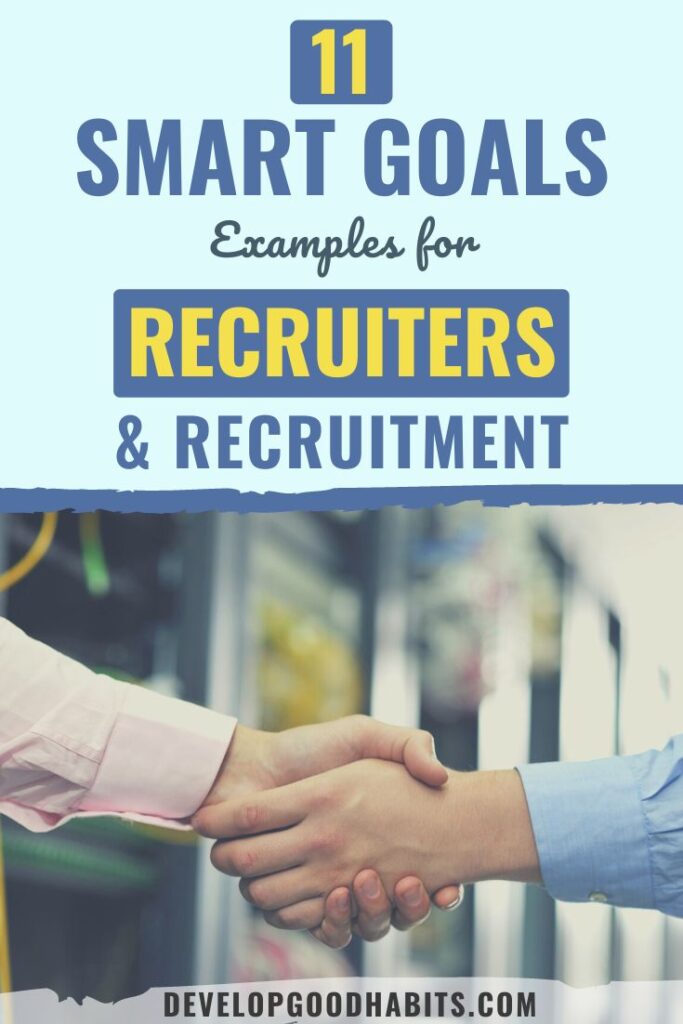There might be affiliate links on this page, which means we get a small commission of anything you buy. As an Amazon Associate we earn from qualifying purchases. Please do your own research before making any online purchase.
In a fast-paced, target-driven recruitment industry, you need to develop strategies to find the best hires. Becoming a great recruiter or talent advisor will produce the best results. Setting SMART goals is an effective way to get the results you want and drive your career progression.
This article presents seven smart goals for recruiters and recruitment examples to design concrete goals that help you thrive.
What Are Smart Goals?
The groundwork for all completed goals is the SMART goal. SMART goals are a structure used to set broad goals to improve your performance, quality of work, and productivity throughout your recruitment career.
SMART is a mnemonic acronym where each letter represents an element or objective of the goal. Here is what each letter stands for:
Specific
SMART goals must be specific to achieve one outcome. The clearer the details, the more likely you are to achieve them. The components typically include numbers or percentages and answer the five W questions:
Who
Who needs to be involved in your goal to achieve it? Will you need assistance from others, or will you be working in a group, for example?
What
What are you trying to accomplish? Be as detailed as possible.
When
When defining your SMART goals, a time to complete them should be set.
Where
This is not always applicable, especially if the SMART goal is personal. However, if a particular location or event is involved, include it.
Why
What is your reason for the goal? Is it for career development or company advancement? Being clear on why you’re working on this goal can help with motivation.
Measurable
The result should be measured against a standard or metric to measure your progress and determine that the goal is complete. For example, you may want to increase your company’s Applicants-per-opening numbers. Check how the number has changed at the end of the goal to verify whether your target has been met.
Attainable
A SMART goal is feasible and realistic to achieve. This section focuses on attainability and what you may need to make the goal happen. First, you’ll outline how the goal will be accomplished and whether you have the tools/skills necessary. If not, what do you need to do to attain them?
Relevant
For your goal to be relevant, it should align with your career or personal objectives, or job functions. This is another way to stay motivated when the relevancy of your goal is kept in mind.
Time-Bound
Your SMART goal will need completion dates or time frames. A target date to deliver your goal is essential to its success, as it helps you stay on track. In addition, an end date constraint creates a sense of urgency.
Unmet goals are typically due to poor detail, making them hard to manage. The combination of the SMART components makes your goals transparent, trackable, and achievable. In addition, its solid foundation provides you with a higher chance of achieving them.
For more information about SMART goals, check out our “Ultimate Guide to SMART Goals” post.
And if you want to know how to turn your goals into habits, then watch this video:
Why SMART Goals Are Important for Recruiters
In general, setting well-defined recruitment or self-improvement goals for yourself makes you a valuable asset to your company. They act as a plan of action for career progression through achieving targets, for example:
Finding and Placing High-Quality Candidates
You can use a SMART goal to define how you’ll go about improving your number of relevant candidates per job order. It will outline details like the number of candidates and the time frame.
Improve Your Companies Recruitment Process
You may see how your companies recruitment process could be more streamlined. Using a SMART goal, you can identify what you need to get a new process up and running. Perhaps new software is required. How will you convince the movers and shakers at the company to fund the project?
Working on goals such as these will go a long way to becoming the recruitment or talent advisor you want to be. So now, let’s look at some SMART goal examples to base your goals on to thrive in your career.
11 SMART Goal Examples for Recruiters
1. Gain 1,000 LinkedIn Followers
“To increase company visibility, I want to gain an extra 1,000+ LinkedIn followers to our company feed within the next 12 months, and most of our company’s revenue comes from LinkedIn.
So I’ll encourage engagement through regular posting on useful recruitment content and news during this time. And using various other social media marketing strategies.”
S: The goal outlines exactly how this person will increase their company’s visibility on LinkedIn.
M: The aim is to increase the current following by 1,000+. The current number of followers can be compared to the number at the end of the time frame.

A: This goal is realistic and achievable.
R: Setting a goal like this demonstrates proactiveness and increases the company’s growth and visibility to applicants and employers.
T: The objective is due to complete at the end of 12 months.
2. Double the Number of Posts
“To expand our pool of talented candidates by 1,000, I will double the number of posts our company feed creates each week over the next six months.”
S: This statement outlines how you will use the company’s social media account to attract more candidates.
M: The aim is to increase the current number by 1,000.
A: 1,000 extra candidates within 12 months is achievable.
R: Attracting more candidates is a significant responsibility of a recruiter. And using social media to achieve it is one sure way of getting promoted.
T: The 1,000 candidate increase goal should be met at the end of six months.
3. Increase Email Subscribers
“I will increase our email subscribers by 500 subscriptions within the next 12 months by writing one piece of original content each month.”
S: This recruiter defines how they will increase their email subscriptions.
M: The achievement of the goal will be verified by a 500-subscription increase.
A: This goal is achievable.
R: Adding to the companies visibility using any method increases growth. A goal like this not only adds to your repertoire of skills, but the marketing effort also offers ROI and has promotion written all over it.
T: A time frame of 12 months has been set to achieve the 500 additional subscribers goal.
4. Work More Closely with Hiring Managers
“As part of working towards becoming a talent advisor, starting from January 1st, 2022, I will work more closely with hiring managers to create effective interviewing strategies and plans.
For more positive hiring decisions and candidate experience. Once a candidate is hired, I will get feedback about their experience in the interview process. Over 12 months, I will check in with companies to see which candidates have passed the probation period.”
S: The statement outlines one goal that will contribute towards achieving another goal of becoming a talent advisor. Essentially, the recruiter will work with the hiring manager to improve the interviewing process.
M: Improvements will be measured using candidate feedback and verifying whether hired candidates have secured a job role by passing the probation period.
A: This goal is achievable.
R: Working closely with hiring managers in this way is part of what a talent advisor does. Proactively going after this type of experience puts you in an excellent position to progress to that role.
T: This goal has been set for 12 months. Once the time is up, the recruiter can present how it has made a difference.
5. Increase the Number of Applications via Website
“For the next quarter, I will increase the number of applications via our website by 15%. Using stronger job descriptions, outreaching via LinkedIn and spreading the word using other social media platforms.”
S: This statement states how they will increase the number of applications to the company website by 15%.
M: The increase in the number of applications will be determined by comparing the number before and after the goal is complete.

A: This goal is achievable.
R: The goal is to increase the company’s profits by attracting more business and utilizing their website more than job boards. All this goes a long way to standing out and career progression.
T: The time frame here is during the next quarter. At the end of the following quarter, numbers can be analyzed to verify whether the goal has been met.
6. Start a Meditation Habit
“As a new addition to my lifestyle. I will manage my stress levels by implementing a meditation practice. Starting from next Monday, I will meditate every day for 10 minutes in the mornings. Every Friday, I will take a blood pressure reading to check it is normal.”
S: This is an example of a personal goal. The recruiter describes how they will incorporate meditation into their lifestyle to manage stress.
M: They will measure whether their new practice is working by checking their blood pressure.
A: This goal is achievable.
R: Finding a way to manage stress levels is vital for increased productivity, higher job satisfaction, and many other work/personal life benefits.
T: This is an example of a life-long goal, as stress will always require management. Progress will be monitored every week.
7. Exercise at Least Four Mornings a Week
“I will exercise more to boost my well-being, improve focus, and assist me in my recruitment career. Starting from April, I will exercise at least four mornings a week.
I will listen to high-energy music during workouts and attend classes for motivation and support. I will notice how exercise supports me in producing high-quality work progressing my other goals.”
S: This statement outlines a self-improvement goal. It mentions why the recruiter will exercise, how often, and how they’ll keep motivated.
M: The recruiter will see how exercise adds their career advancement
A: This goal is achievable.
R: Regular exercise contributes to many positive advantages, including a faster memory, enhanced creativity, and better concentration – all welcome benefits in support of career growth.
T: This is another example of a life-long SMART goal, where the recruiter will exercise a least four times a week.
8. Increase Efficiency in Sourcing Candidates
“I will improve our candidate sourcing process by learning and applying advanced Boolean search techniques and utilizing social media platforms. I aim to increase the number of qualified candidates I source weekly by 20%.
To achieve this, I'll provide training in advanced search techniques and ensure my team and I have access to premium sourcing tools. This will meet our company's goal of reducing time-to-fill positions, and I aim to achieve this 20% increase within the next three months.”
S: Implement advanced Boolean search techniques, a methodology allowing us to narrow, broaden, or better refine search results. We will also use specific social media platforms to improve the candidate-sourcing process.
M: Meet a weekly goal of increasing the number of qualified candidates sourced by 20%.
A: This goal is achievable by providing recruiters access to premium sourcing tools and training them in advanced searching techniques.
R: By enhancing efficiency in candidate sourcing, company goals of reducing time-to-fill positions will be met.
T: Setting the 20% goal within three months satisfies time-bound constraints.
9. Improve the Candidate's Experience
“I am committed to enhancing the candidate experience by implementing a personalized communication plan. My goal is to improve candidate satisfaction scores by at least 15% based on post-application surveys.
To make this happen, I will develop and execute a communication plan that includes personalized messages at key touchpoints throughout the hiring process. Improving the candidate experience is crucial for our employer branding and talent retention efforts and I will achieve this 15% improvement within six months.”
S: Implementing a personalized communication plan for each specific candidate. To be effective, the communication plan will itemize what candidates can expect by implementing timely responses during their hiring process and professionalism from their recruiter.
M: Based on data from post-application surveys, improve candidate satisfaction by 15%.
A: Key touchpoints will include personalized messages via developing and implementing a communication plan.
R: The organization will ensure candidates have a better experience, thus satisfying retention efforts.
T: Aim to achieve a 15% improvement in candidate satisfaction within the next six months.
10. Streamline the Hiring Process for Critical Positions
“I am determined to streamline our hiring process for critical roles by identifying bottlenecks and implementing process improvements. I aim to decrease the average time-to-hire for critical positions by 20%.
To achieve this, I will conduct a thorough process analysis to identify and address inefficiencies in our hiring workflow. Reducing time-to-hire for critical roles is essential to meeting our strategic goal of ensuring key positions are filled promptly, and I plan to achieve this 20% reduction within the next six months.”
S: Reduce time-to-hire for critical roles by identifying bottlenecks in the process and implementing improvements.
M: For critical positions, decrease the average time-to-hire by 20%.
A: I will identify and address hiring inefficiencies by conducting a process analysis. This may include not having a streamlined application process, lengthy approval process, lack of qualified candidates, or timeliness in filling job positions.
R: By reducing time-to-hire for critical roles in the company, strategic goals of ensuring positions are filled in a timely manner will be satisfied.
T: Within the next six months, achieve a 20% reduction in time-to-hire for critical positions within the company.
11. For High-Priority Roles, Increase the Rate Offers are Accepted
“I am committed to enhancing our offer acceptance rate for high-priority roles by addressing potential obstacles in the negotiation process. I aim to increase the offer acceptance rate from our current 75% to an impressive 90% within the next six months.
To achieve this, I'll work closely with hiring managers to understand candidate expectations better, provide negotiation training to our recruiting team, and craft more competitive and appealing offers.
This goal directly supports our organization's need to secure top talent swiftly, and I am determined to reach this 90% acceptance rate within the specified timeframe.”
S: In the offer negotiation process, potential barriers will be identified and addressed to improve offer acceptance rates for high-priority roles in the company.
M: Within the next six months, increase the offer acceptance rate of critical roles by 25%. This can be accomplished by reviewing and improving candidate selection processes, ensuring job offers are competitive in the market, and communicating effectively with job applicants.
A: While I work on creating more attractive and competitive offers, I'll also collaborate closely with hiring managers to understand expectations and provide negotiation training to recruiters.
R: To reduce the risk of losing qualified candidates to negotiation challenges, this goal aligns with the organization's need to secure top talent for high-priority positions.
T: Achieve a high-priority role acceptance rate by qualified candidates over the next six months.
Final Thoughts on Smart Goals for Recruiters
SMART goals are explicit to ensure success. There is no way of cheating as metrics verify whether the plan has been achieved or not when using this format. SMART goals for recruiters can be short-term to enable you to get to a certain point quickly or a long-term goal as an addition to your lifestyle.
And if you want more SMART goal ideas and examples, be sure to check out these blog posts:
- 15 SMART Goals Examples for HR (Human Resources) Professionals
- 13 SMART Goals Examples for Improving Your Communication Skills
- 11 SMART Goals Examples for a Job Promotion
Finally, if you want to take your goal-setting efforts to the next level, check out this FREE printable worksheet and a step-by-step process that will help you set effective SMART goals.


